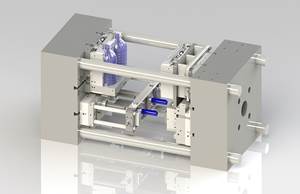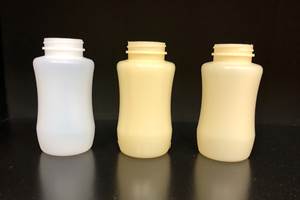NPE2018 New Technology Focus: PET Machines Stretch the Limits
A huge variety of new one- and two-stage machines are blowing PET bottles and jars at the show.
PET stretch-blow systems are the largest single category of blow molding machines at the show. New versions offer higher outputs, increased flexibility, easier changeovers, and greater versatility to handle complex or “difficult” bottle shapes.
In one-stage injection-stretch-blow (ISBM) systems, Pet All Manufacturing (Booth W6545) is exhibiting for the first time its new ISBM-180E all-electric unit. The four-station rotary machine has a 15-ton clamp and handles six to 10 cavities for containers from 10 to 100 ml.
Kiefel Technologies (Booth W2727) is showing for the first time in the U.S. the Blowliner single-stage ISBM machine from its subsidiary Mould & Matic Solutions. Major advantages of this machine are said to be its compactness and versatility. It can process PET, PP, and HDPE; it can also be upgraded to multilayer barrier applications. It can mold containers from 10 ml to 5 L on the same machine.
In its largest NPE booth ever (Booth S19045), Nissei ASB Machine Co. is bringing five stretch-blow machines—both one-stage and two-stage—to Orlando, demonstrating a number of upgrades and special options that enhance productivity and allow production of a wide range of specialty PT containers from beer bottles, airline liquor miniatures, and sports drinks to premium cosmetics and wide-mouth jars that can accept a metal lug cap. One new model, ASB-150DPX, is said to be the “world’s first triple-row, one-step injection stretch-blow machine.” Making its debut in the Americas, this machine is molding 50-ml airline liquor miniatures in what ASB says is an “unprecedented” 48 cavities with a cycle time of 8.6 sec, for output greater than 20,000 bph.
In two-stage (reheat) machines, Pet All is showing the new CPSB-1000 LLE all-electric machine from Chum Power in Taiwan. This linear machine has continuous motion of preforms. It molds large containers of 10-20 L.
KHS Group (Booth S12045) has developed a new version of its high-output InnoPET Blowmax rotary RSBM system to meet rising demand for single-serve beverage bottles in the 250- to 800-ml size range. The system is more compact, but its small mold carriers process up to 2500 bottles/hr per station.
KHS also is showing off its Factor 100 PET bottle that debuted last fall at the Drinktec show in Germany. At 5 g, it’s said to be the lightest known half-liter PET bottle for still water.
W. Amsler Equipment (Booth S21067) has introduced the next generation of its linear stretch-blow molder as well as a newly enhanced leak tester. The L42X all-electric reheat machine offers several new features for custom PET blow molders, including preferential heating, neck orientation, and hot-fill capability. It can make containers up to 2 L in four cavities at up to 6500/hr. It can also run two-cavity molds for containers up to 5 L. Neck finishes range from 18 to 70 mm.
SIDE S.A. of Spain (Booth S16084) is presenting its new generation of linear reheat machines. These include the model 2006e, which takes up to six cavities for products from 250 ml to 3 L and output up to 10,000 bph. Model 2003eG is a two-cavity unit for up to 10 L containers and outputs from 2200 to 2600 bph.
SIDE will also feature its T-handle technology (also shown at NPE2015), which produces PET jugs with a pinched handle up to 36 mm deep through compression molding in the tool.
1Blow of France (Booth S14089), which supplies extremely compact RSBM systems, will highlight its next-generation Model 4LO for custom PET bottles. This all-electric system runs up to four cavities and bottles up to 2.5 L. It can accommodate preferential and offset-neck heating; neck orientation for flip-top caps (without requiring a tab or notch in the preform neck); heat setting; base inversion for hot filling; and Sure Grip, which imparts a deeper grip into the bottle than can be produced in standard stretch-blow systems.
Terekas UAB of Lithuania (Booth S10196) will present the newest version of its highly versatile FlexBlow RSBM system. The FlexBlow 2 WM is able to produce both wide-mouth (up to 110 mm) and narrow-neck (18-mm) containers. It can mold up to 73-mm necks in two cavities and wider in one cavity. Bottles from 1.5 to 3 L can be molded at 700 to 750/hr. Changing the bottle format, including molds, neck, and gripper parts, and fine-tuning the machine settings afterward, reportedly takes no longer than 30 min. Another new feature is customized preform grippers made by 3D printing. They allow for very precise detailing in custom designs.
PET Technologies GmbH of Austria (Booth S10057) has brought to market its fourth generation of reheat machines, called APF-Max, with output range 6000 to 14000 bph for bottles of 0.2–3 L. The series has 4, 6, or 8 cavities. A machine can be upgraded from 7000 bph to 14000 bph by installing extra ovens and mold cavities. The company says 15 min are enough to change the blow mold and start production of another bottle format. Only 2 hr are needed for changeover to another preform neck standard.
Related Content
Plastics Technology Year in Review: Your Favorite Reads of 2024
A year-end review of the top stories showcasing industry trends, advancements and expert insights. Revisit the articles that captured the attention of the plastics community.
Read MoreAt NPE, Cypet to Show Latest Achievements in Large PET Containers
Maker of one-stage ISBM machines will show off new sizes and styles of handled and stackable PET containers, including novel interlocking products.
Read MoreProcessing Megatrends Drive New Product Developments at NPE2024
It’s all about sustainability and the circular economy, and it will be on display in Orlando across all the major processes. But there will be plenty to see in automation, AI and machine learning as well.
Read MoreHow to Extrusion Blow Mold PHA/PLA Blends
You need to pay attention to the inherent characteristics of biopolymers PHA/PLA materials when setting process parameters to realize better and more consistent outcomes.
Read MoreRead Next
Beyond Prototypes: 8 Ways the Plastics Industry Is Using 3D Printing
Plastics processors are finding applications for 3D printing around the plant and across the supply chain. Here are 8 examples to look for at NPE2024.
Read MorePeople 4.0 – How to Get Buy-In from Your Staff for Industry 4.0 Systems
Implementing a production monitoring system as the foundation of a ‘smart factory’ is about integrating people with new technology as much as it is about integrating machines and computers. Here are tips from a company that has gone through the process.
Read More




















